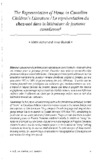| dc.contributor.author | Reimer, Mavis | |
| dc.contributor.author | Rusnak, Anne | |
| dc.date.accessioned | 2019-02-05T17:42:19Z | |
| dc.date.available | 2019-02-05T17:42:19Z | |
| dc.date.issued | 2001 | |
| dc.identifier.citation | Reimer, Mavis, and Anne Rusnak. “The Representation of Home in Canadian Children’s Literature/La représentation du chez-soi dans la littérature de jeunesse canadienne.” Canadian Children’s Literature 26.4/27.1 (2001): 9-46. | en_US |
| dc.identifier.issn | 0319-0080 | |
| dc.identifier.uri | http://hdl.handle.net/10680/1617 | |
| dc.description.abstract | Les auteurs du présent article soutiennent que l'étude du «chez-soi» dans les romans pour la jeunesse permet d'accéder aux valeurs socioculturelles fondamentales que ceux-ci véhiculent. L'analyse porte tout particulièrement sur les constantes narratives de plusieurs romans canadiens, anglais et français, qui ont paru entre 1975 et 1995, et qui ont obtenu des prix littéraires. Il semble que les romans francophones privilégient un «ailleurs» qui, involontairement au non, s'impose à l'espace familial au familier, tandis que dans la plupart des romansanglophones, le personnage enfant choisit des,etablir ailleurs, mais à une différence majeure près: l' «ailleurs» est choisi par le personnage enfant mais se voit plus volontiers assimilé au «chez soi».
In this paper,the authors begin from the premise that a study of the idea of "home" in Canadian children's literature allows access to the values, beliefs, and assumptions of this literature. They compare French-language and English-lan guage novels that won awards in Canada between 1975 and 1995, considering in particular the narrative patterns of these novels. They conclude that there is a clear dominant pattern in French Canadian children's novels, in which an "away" in vades or is invited into the home; this pattern is also popular in English Canadian children's novels, but the most prevalent pattern is one in which an "away" setting is chosen as home by the central child character. In their analysis of these award winning novels, the authors begin to speculate on the significance of the differences and similarities they have found. | en_US |
| dc.description.sponsorship | Work on this project has been supported by grants from the University of Winnipeg
and by the France E. Russell Award given by the International Board on Books for
Young People. | en_US |
| dc.description.uri | http://ccl-lcj.ca/index.php/ccl-lcj/article/view/3722 | en_US |
| dc.language.iso | en | en_US |
| dc.publisher | Canadian Children’s Literature | en_US |
| dc.rights | info:eu-repo/semantics/openAccess | |
| dc.title | The Representation of Home in Canadian Children’s Literature/La représentation du chez-soi dans la littérature de jeunesse canadienne | en_US |
| dc.type | article | |

